Posted on
August 18, 2014 by
Eva Thompson
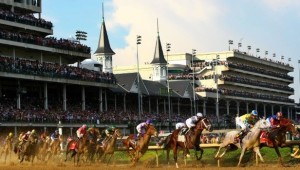
The horse racing industry in the United States brings in over $26 billion each year.
Horse racing provides a full spectrum of entertainment unlike any other sport. Whether your horse wins or loses, spending a day at the races makes for a great afternoon or evening outdoors watching beautiful animals compete.
The Tradition of Horse Racing
Horse racing has been a long standing tradition among many cultures. The sport dates back all the way to 4500 BC among nomadic tribesmen in Central Asia, who first domesticated horses. Archeological records reveal that the Ancient Greeks, Syrians, Babylonians, and Egyptians also participated in horse racing to entertain the masses and honor outstanding horsemanship required for battles. Later horse racing became popular among British royalty and aristocracy where it received the nickname “Sport of Kings”.
These days, horse racing represents one of the only legal forms of gambling around the world, including Great Britain, Ireland, Canada, the United States, South America, the Middle East, and Australia. Read the rest of this entry →
Tags: AffirmedHorse RacingSeabiscuitSecretariat
Category
Horse Racing, Sports History
Posted on
August 11, 2014 by
Martin Banks
Now that the calendar has turned to August, the eyes of the racing world have turned to the historic Saratoga Race Course in beautiful Saratoga Springs, N.Y. This town is wonderful to visit any time of the year, but it really springs to life during the summer racing meet, when top thoroughbreds converge to compete in top-quality races.
Saratoga has been hosting summer races since 1863, and over the years it has become known as the “graveyard of champions.” This refers to the fact that many times, horses that seemed invincible went down in stunning defeat. Although races like these can lead to huge payoffs for bettors, it comes at great expense to champion horses. Two of these horses share that history and also the nickname of Big Red. They were Man ‘o War and Secretariat.
Man o’ War Melts
![1 R UMAX Mirage IIse V1.1 [4]](http://sportsthenandnow.com/wp/wp-content/uploads/2014/08/manowar-300x240.jpg)
Man o’ War was a stunning chestnut colt who raced in the years 1919 and 1920. When he competed in the Sanford Stakes for 2-year-olds on Aug. 13, 1919, his reputation was already such that he seemed a lock to win. His previous six victories were so impressive that it seemed it was impossible for him to lose. In fact, this was the only race that he ever would lose in his entire racing career.
Starting gates were not used at this time, and starters had to make sure horses were properly lined up behind a tape barrier and ready to race. Unfortunately for Man o’ War, the tape was sprung when he was apparently backing up. Essentially, he was left at the start. Read the rest of this entry →
Tags: Horse RacingMan O' WarSaratogaSecretariat
Category
Horse Racing, Scott Huntington
Posted on
July 11, 2014 by
Martin Banks
With the defeat of California Chrome in the Belmont Stakes, we were robbed of witnessing one of the greatest accomplishments in American Sports: the completion of the Triple Crown. Only eleven horses have won the Kentucky Derby, the Preakness and the Belmont Stakes — the three races that make up that vaunted title. Some names of Triple Crown winners are more memorable than others, but let’s take a look at three of the most notable.
Sir Barton
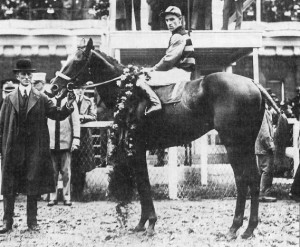
Sir Barton was the first horse to win the Triple Crown, when he won the Belmont Stakes in 1919. Originally, Sir Barton was just supposed to be the pacemaker for a higher regarded horse named Billy Kelly, but that all changed when Sir Barton won the Triple Crown by five lengths. He never trailed in any of the races he competed in, but somehow Sir Barton never really got the recognition he deserved.
His legacy was somewhat marred when he lost a match race against the famous Man o’ War. Sir Barton had some hoof problems that were compounded by the track’s hard surface, which led to his seven length loss to Man o’ War. Still, being the first ever Triple Crown Winner is something Sir Barton could be very proud of. Read the rest of this entry →
Tags: Horse RacingSecretariatSir BartonWar Admiral
Category
Horse Racing, Scott Huntington, Sports History
Posted on
February 19, 2013 by
Dean Hybl
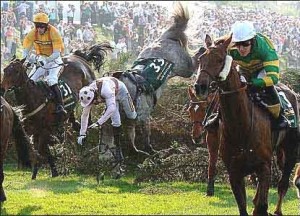
The Aintree Racetrack offers challenge for both the jockey and horse.
While the Kentucky Derby is the best known horse racing event in the United States, a month prior to the Derby, Liverpool, England will serve as the host for a very different, yet equally exciting horse racing spectacle. The 2013 John Smith’s Aintree Grand National Hunt race is the world’s most popular steeplechase event.
Originally held at the Aintree Racetrack in 1839, the 2013 event is slated for April 6th and serves as the culmination of the three-day Aintree Festival.
The Grand National provides a unique set of challenges that only the best jockeys and horses can conquer.
The racecourse is triangular in shape and includes 16 fences, all except The Chair and the Water Jump are jumped twice. The course has a reputation as the ultimate test of horse and jockey, and just completing the two circuits is considered a great accomplishment. Some of the fences are famous for their difficulty, most specifically Becher’s Brook, The Chair, and the Canal Turn.
Unlike the Kentucky Derby and American Triple Crown, which includes the best three-year-old horses, the Aintree Grand National is typically won by a horse with far more years and experience.
In 2012 11-year-old Neptune Collonges, ridden by jockey Daryl Jacob for trainer Paul Nicholls and owner John Hales was able to conquer the challenging track and claim victory in the Grand National. He was the oldest winner of the Grand National since 12-year-old Amberleigh House in 2004.
The oldest horse to win the Grand National was 15-year-old Peter Simple in 1853. Since 1994 the youngest horse to win the race was eight-year-old Bindaree in 2002 and the race has been won 12 times in that stretch by a horse with double-digits in the age column.
For many, one of the great allures of this annual event is the many betting opportunities and certainly the recent history of older winners is one thing for those who enjoy betting on this exciting event to consider as they ponder which horse and jockey they will support. Through William Hill Grand National 2013 you can watch all the races of the three-day festivities through livestreaming and also keep track of the latest betting odds and opportunities.
Tags: Grand NationalHorse RacingJohn Smith's Aintree Grand National
Category
Horse Racing
Posted on
July 06, 2011 by
Dean Hybl
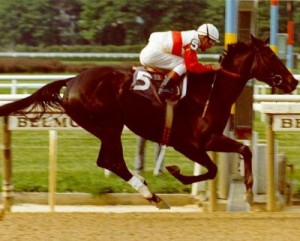
Many consider Ruffian to be the greatest female horse of the 20th Century.
It was 36 years ago today that an event created to be a celebration of horse racing greatness turned tragic and resulted in the death of one of the top female racehorses of all-time.
A coal black filly with champion blood lines that included Native Dancer and Bold Ruler, Ruffian had no equals during her two year racing career and was U.S. Filly Champion as a two and three year old.
In 10 career races, Ruffian was never defeated and in 1975 claimed the Filly Triple Crown (now called the Triple Tiara). She established a new record in eight different stakes races, seven of which still stand.
Her dominating victories against female horses led many to wonder if she was capable of competing with the top male horses of her time.
This led on July 6, 1975 to a match-race between Ruffian and 1975 Kentucky Derby winner Foolish Pleasure at Belmont Park. Coming only two years after the Billie Jean King-Bobby Riggs “Battle of the Sexes”, the race was promoted as a chance for America’s finest filly to show her overall dominance in the “Equine Battle of the Sexes”.
Interestingly, jockey Jacinto Vasquez was the primary rider for both horses, but chose to ride Ruffian for the match race and many experts fully expected Ruffian to pull off the victory. Read the rest of this entry →
Tags: Foolish PleasureHorse RacingRuffian
Category
Horse Racing, Sports History
Posted on
May 05, 2011 by
Dean Hybl
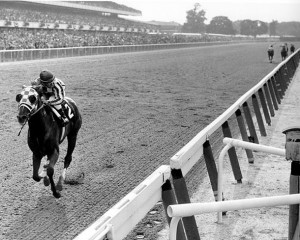
Secretariat dominated thoroughbred racing in 1973 and was named as the 35th greatest athlete of the 20th Century.
There was a time when the most important sporting event on the first weekend of May wasn’t the NBA or NHL Playoffs, but rather a two minute race between the fastest three-year-olds on four legs. While still an exciting event for those lucky enough to make it to Churchill Downs, the Kentucky Derby and thoroughbred racing in general isn’t quite the national obsession that it once was.
However, the history of this regal sport is laced with many great champions, some of whom captured the spirit and hearts of the American public.
While greatness for a thoroughbred is often identified with winning the famed Triple Crown (Kentucky Derby, Preakness Stakes and Belmont Stakes), only some of the best known horses actually claimed that distinguished honor.
Chances are you have never heard of the first Triple Crown winner, Sir Barton, in 1919, but may have heard about the legendary Man O’War, who many consider the greatest horse of all-time with victories in 20 of his 21 races. However, Man O’War did not follow Sir Barton as a Triple Crown winner during his three-year old year of 1920 as his owner held him out of the Kentucky Derby. Read the rest of this entry →
Tags: Horse RacingKentucky DerbyMan O' WarSecretariatsmarty jones
Category
Great Moments, Horse Racing, Sports History

![1 R UMAX Mirage IIse V1.1 [4]](http://sportsthenandnow.com/wp/wp-content/uploads/2014/08/manowar-300x240.jpg)



